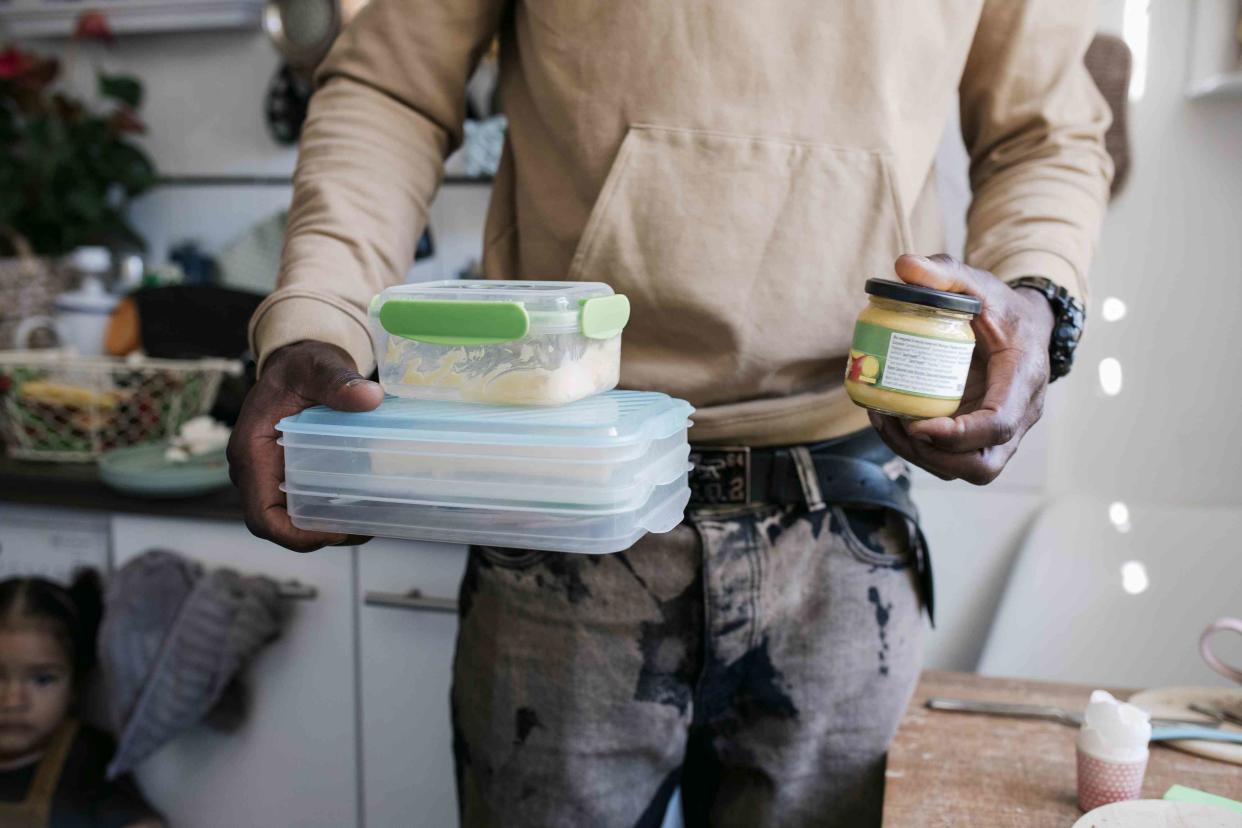How Do You Know If It's Time to Replace Your Plastic Tupperware?

Fact checked by Nick Blackmer
Key Takeaways
Plastic food storage containers should be replaced regularly to avoid transferring contaminants from previous use and potential leaks or spoilage of stored food.
While there is no set timeframe for replacing plastic food containers, experts say they should be tossed out when they show visible wear, chips, cracks, or signs of stains and odors.
In place of plastic containers, experts recommend opting for glass or stainless steel instead.
When it comes to storing and keeping your food fresh, transporting lunches and snacks, or even getting ahead with meal prep, it’s pretty common to reach for plastic food containers. In fact, nearly 200 million Americans used disposable food storage containers in 2020.
Despite how frequently they get used in the kitchen, it’s easy to forget plastic food containers, like other household items such as toothbrushes, sponges, and cookware, need to be replaced once in a while too.
Here’s why you should be replacing them regularly, what signs indicate it’s time to toss them, and Tupperware alternatives you can try instead, according to experts.
Why You Need to Replace Plastic Food Containers
Although many plastic food containers are durable and can last a long time, they should be replaced regularly, Andrea De Vizcaya-Ruiz, PhD, associate professor of environmental and occupational health at the University of California Irvine, told Verywell in an email.
“When they show any wear, damage, or deterioration,” it’s time for them to go, Vizcaya-Ruiz said. Single-use plastic containers, like the ones you usually get from take-out restaurants, are not intended for long-term use.
Here’s exactly what you should be looking for:
Visible wear and tear: Check your plastic food containers for any cracks, chips, scratches, sticky surfaces, or warping. Vizcaya-Ruiz said if you notice any visible damage, you should replace the container, because these defects can “compromise the integrity of the product and make it more difficult to clean thoroughly.”
Stains and odors: While something like a tomato sauce stain is often not a safety concern, persistent staining paired with odor may signal it’s time for replacement. Stains and odors may be indicative of lingering food residue or bacteria, which can affect the taste and safety of food, or even increase the risk of cross-contamination.
Improper seal and fit: Lids that come with your plastic food containers should have a tight and secure seal. It’s also important they close properly. Having a proper seal helps maintain food freshness and can prevent contamination.
Microwave or dishwasher damage: You should avoid heating single-use plastic containers in the microwave or washing them in the dishwasher, Vizcaya-Ruiz said, since it can cause the product to warp or degrade over time. The degrading process generates microplastics that are dangerous for human consumption and are even linked to cancer. While plastic containers labeled microwave- or dishwasher-safe have more leeway than takeout containers, they will eventually start to degrade too. Check for signs of warping, melting, or cracking due to exposure to high heat.
Be Careful What You Store
If you use your plastic containers to store things that are harmful to consume, such as motor oil or paint, you should avoid reusing them for food storage, and consider replacing them entirely. That’s because chemicals may contaminate the surface of the container, and thoroughly sanitizing it is difficult.
If you overuse plastic containers, you risk transferring contaminants from previous use. Plus, an old, damaged container won’t properly hold your food.
“If the container cannot be properly cleaned, any contaminate left in the container can be transferred to the food you put into it,” Martin Bucknavage, MBA, MS, senior food safety extension associate at the Penn State Department of Food Science, told Verywell. “If it does not properly seal, the container can leak or food may spoil.”
Related: You May Want to Think Twice About Reheating Leftover Rice
How Often to Replace Your Plastic Food Containers
There is no one-size-fits-all rule for replacing plastic food containers. It largely depends on the condition of the containers themselves and how often they have been used and maintained, Vizcaya-Ruiz said.
She recommends assessing any plastic containers you use frequently once a month. For anything you use only periodically, once every three months is fine. However, you should always follow the manufacturer’s recommendations for the specific type of plastic container you have.
Safer Storage Solutions to Consider
Instead of using plastic containers, experts suggest opting for storage options that are chemically inert. This means they won’t react with other substances or undergo chemical changes when exposed to heat.
Vizcaya-Ruiz said that stainless steel, ceramic, or porcelain containers are other examples of durable, sustainable plastic alternatives.
Bucknavage recommends glass containers. Although they can be more expensive and heavier than plastic, they’re more resistant to damage and staining—including after being heated. Even if you store your food in plastic containers, consider transferring it to glad ahead of microwaving it.
“When exposed to high temperatures, plastic containers can release toxic chemicals, such as phthalates and bisphenol A (BPA), into the food they hold,” Vizcaya-Ruiz said. “These chemicals have been found to disrupt hormones and may cause various health issues, including reproductive problems.”
What This Means For You
Regular replacement of Tupperware and similar plastic food storage containers can benefit your health and your food.
Read the original article on Verywell Health.

